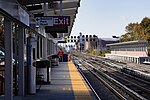Queens Village station
1879 establishments in New York (state)Long Island Rail Road stations in New York CityRailway stations in Queens, New YorkRailway stations in the United States opened in 1879Use mdy dates from September 2019

Queens Village is a station on the Long Island Rail Road's Main Line, located between 218th Street and Springfield Boulevard, in the Queens Village neighborhood of Queens, New York City. It has two side platforms along the four-track line, and is served by Hempstead Branch trains. Just east of the station is Queens Interlocking, a universal interlocking that splits the four-track line into two parallel two-track lines—the Main Line and Hempstead Branch—and controls the junction with the spur to Belmont Park. The station is elevated and the tracks leading in and out are on raised ground and only above the road at intersections.
Excerpt from the Wikipedia article Queens Village station (License: CC BY-SA 3.0, Authors, Images).Queens Village station
97th Avenue, New York Queens
Geographical coordinates (GPS) Address Nearby Places Show on map
Geographical coordinates (GPS)
| Latitude | Longitude |
|---|---|
| N 40.717469 ° | E -73.73638 ° |
Address
97th Avenue 218-31
11429 New York, Queens
New York, United States
Open on Google Maps







